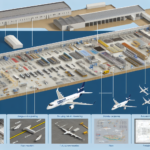Throughout my 31 years in aviation, I’ve come to realize that nearly every pilot views their hometown as the mythical Lake Wobegon, a place where “all the women are strong, all the men are good-looking, and all the children are above average.” This means that if we weren’t already self-assured individuals before entering aviation, the sheer experience of flying and observing those on the ground only reinforces those beliefs.
I have yet to meet a pilot who considers themselves below average, and among the least competent individuals I’ve flown with, confidence in their skills has always remained high. Yet, I too harbored the belief that I was an exceptional aviator—until recently, when undeniable evidence revealed that I am, in fact, just average. This realization forced me to confront a more humble perspective about my abilities.
One tool that contributed significantly to this self-assessment is FlightPulse, a flight data analysis platform created by GE Aerospace. My airline utilizes it both for internal assessments and as a pilot-facing application on our iPads. FlightPulse is a modern adaptation of a broader initiative, known as Flight Operations Quality Assurance (FOQA), which has been evolving over the last 20 years. Airlines involved in FOQA equip their aircraft with quick access recorders that collect detailed flight information, allowing for nearly real-time monitoring of safety trends and recording significant events that might otherwise go unreported. This program has been key to enhancing safety records among U.S. carriers over the years.
Many might assume that airline pilots would strongly oppose such surveillance, and there were indeed objections in the past. Years ago, the Air Line Pilots Association (ALPA) even threatened to strike over proposals to utilize flight data recorders and cockpit voice recorders for monitoring purposes. However, FOQA’s creation was a collaborative effort involving the FAA, airlines, and pilot unions, resulting in a mutual agreement that the data collected would not be used for punitive actions. So far, all parties have adhered to this agreement. A pillar of this initiative is ensuring anonymity, meaning flight data has typically been de-identified for all users, with one major exception—the gatekeeper.
The gatekeeper is a pilot who works for management but represents the union. They are aware of the identities of pilots linked to significant FOQA events and can reach out to those pilots to gather their perspectives and potentially involve them in discussions to review data in a supportive setting. The gatekeeper investigates contributing factors like fatigue or communication breakdowns, prepares significant event reports for the entire airline, and contributes to the development of training and procedural adjustments based on significant occurrences or negative trends. While gatekeepers do not have disciplinary authority and cannot disclose pilot identities to management, the infrequency of receiving a call from one has made FOQA quite obscure for the typical line pilot until recently.
FlightPulse has changed this dynamic, providing pilots with direct access to our flight data—both our own and that of our peers—laying bare our capabilities and shortcomings. For instance, I recently piloted a Boeing 737-900ER from Salt Lake City to Tampa, Florida. I took off from Runway 34L at a weight of 169,800 pounds, initially rotated at 1.8 degrees per second, and lifted off at a pitch angle of 6.5 degrees. I manually flew the aircraft for the first 13.3 minutes, covering 1,722 nautical miles at an average ground speed of 511 knots, consuming 22,200 pounds of jet fuel. On arrival, I hand-flew the last 8.8 minutes, achieving a stable approach to Runway 19R at an altitude of 1,710 feet. However, I momentarily fell below the target speed before landing, leading to a rather firm touchdown as confirmed by the data.
This information may seem somewhat trivial, but it reinforces that I may not be operating at my peak, especially during red-eye flights. However, a certain flight from Los Angeles (KLAX) to Las Vegas (KLAS) caught my eye because it was flagged as a FOQA event for instability due to an excess descent rate. While it didn’t lead to a call from the gatekeeper, it was noteworthy. The situation arose as we approached Runway 1L in Las Vegas while handling a challenging descent rate, exacerbated by high density altitude and the approach speed of 150 knots, which made achieving a controlled descent especially difficult.
During this flight, I called out a deviation from the glideslope, and the first officer managed the correction effectively, allowing us to land safely rather than executing a missed approach. However, since FOQA data doesn’t capture communication nuances, the situation was logged as an unstable approach continued to landing.
What was advantageous about using FlightPulse was the ability to assess previous flights. It allows us to review common threats encountered on specific routes. Acknowledging that unstable approaches were frequent at KLAS, we had pre-emptively prepared for such challenges during our brief and were able to respond appropriately. The recognition that our event had been flagged aids future crews flying that route with vital information.
Prior to FlightPulse including this research capability, I often logged in to check my numbers against other pilots as a form of ego-boosting, but the reality was somewhat humbling. My performance metrics turned out to be solidly average, offering little distinction. My operational statistics show I’m performing comparably to my peers, with only hand-flying time surpassing averages. I had inadvertently become the epitome of average.
In light of this, I recognize that while I may not possess extraordinary skills, I’m part of a highly capable team of pilots. Perhaps the reflection I see is not just of an average pilot but rather one of many skilled aviators in a competitive field, and I can accept this reality.

This column first appeared in the May Issue 958 of the FLYING print edition.
Based on an article from flyingmag.com: https://www.flyingmag.com/pilot-know-thyself-discovering-what-it-means-to-be-painfully-average/



